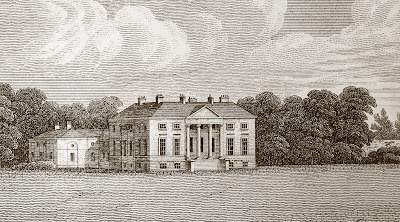Grainsby derives its name not from farmed grain but from
Scandinavian derivation, the word for branch of a river. The area is covered in
small tributaries to the river Humber. The manor of Grainsby dates back to 1086
and a house would have stood on the estate in various forms for all this time.
Grainsby Hall was once owned by the Nettleship family from Lea, Gainsborough in
Lincolnshire and Francis Nettleship lived there for most of the eighteenth
century and is likely to have been responsible for rebuilding the house from an
earlier structure. Francis left the estate to his servant Elizabeth Borrell who
had actually bought the house and 313 acres for £5,800 in 1795 before his death.
Elizabeth in turn left the estate to her great niece Elizabeth Charlotte who
married a Yorkshire land owner William Haigh of Norland, Halifax in 1827, hence
the subsequent Haigh ownership. The Haigh family were very wealthy throughout
the C18th and C19th centuries and built the Garden Street Mill, the second oldest
in Halifax in 1833, which still exists today converted into flats. They also
owned Castell Deudraeth, a
property in Merionethshire, Wales, known as ‘Aber Iâ’ at the time. The estate
there later became part of the fantasy village Portmeirion by Sir Clough Williams-Ellis.
The family regularly travelled around Britain including London, Wales,
Cheltenham spa and the south coast for holidays. Such was the influence of this
family in business and even politics, George Henry Caton Haigh became High
Sheriff of Lincolnshire in 1912.
Grainsby Hall was rebuilt around the C18th shell around 1860
and is recorded as being photographed in 1863 by Warner Gothard & Co of
Grimsby, although only family portraits from this shoot survive. They chose the
fashionable Italianate style with the main feature being a campanile-style
tower. The design was typically asymmetrical, fashionable in architecture at
the time. The new design was in keeping with the social aspirations of the
family at this time.
The hall was a full household, with the 1881 census showing
the owner George Henry Haigh and his wife Emma, with eight children, seven
domestic servants and a governess. This didn’t include the workers in the
estate cottages or the many farm labourers, stable staff and gardeners. In 1888
a Miss Thomas of Cardiff, one of many subsequent governesses was reported as
successfully taking the family to court over the mischievous behaviour of three
of the Haigh daughters. There are also records of some of the staff prior to
this census. A farm labourer on the Grainsby estate was a
William Taylor (b. 1783 – d. 1859) who married one of the house servants Elizabeth
Wells (b. 1783 – d. 1849) in 1803, and went on to have 10 children between 1805
and 1828. They seem to have grown tired with life at Grainsby as some time
later the couple took a huge risk and took most of their youngest children and
emigrated to Cincinnati, Ohio to start a new life in America. The family soon
spread out and are recorded as having been quite successful. Other workers at
Grainsby took to family life on the estate such as John Barker (b. 1810 – d.
1857 to 1861) a mole catcher who married (after 1840) Ann Dows (b. 1824 – d.
after 1881) a charwoman (house cleaner) and they were both resident at Grainsby
hall in the 1851 census. Their daughter Mary Ann also became a servant at the
hall. John’s elder brother Francis Barker (b. 1802) was a farm labourer at the
hall also in 1851 but had left to become a carpenter by 1861. He also married a
fellow Grainsby hall worker, Jane (b. 1813 – d. 1887) and they had two children
registered as living at the hall although in reality this would most likely
have been in the out houses.
The Haighs were wealthy enough to build beyond
their estate and even constructed Grainsby
Halt railway station 2 miles to the east in 1905 to serve the Hall. This
was closed and demolished some time after 1952. Another notable structure next
to the hall, along the north wall of the kitchen garden, was a huge 100-foot
conservatory which would have been used for the production of food, flowers,
herbs etc, and out of season produce needed to sustain such a large family and
workforce. The walls of the garden and the C18th stable block north of it still
survive. The demise of the hall was typical of so many houses at the time. Grainsby
had been requisitioned by the army during WW2 and fell into disrepair
afterwards when maintenance costs had become unsustainable for the family.
Having been used for some time as a grain store, the building, apparently in a
dangerous condition, especially from the roof and upper floor, was demolished
in February 1973.


